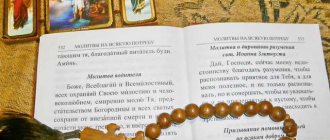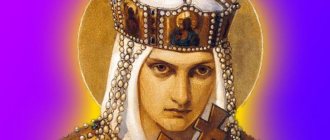Christian rituals are often accompanied by various actions and attributes. Remember, at Baptism, the baby is dipped into the font, and during services for the repose or for health, it is customary to place candles near the corresponding icon in the Temple. Likewise, during a funeral service, a small icon is often placed in the coffin of the deceased. Why this is done and what to do with the sample will be discussed later in the article.
Why is the deceased buried with his belongings?
The custom of placing various things in a coffin along with the deceased arose in ancient times and is practiced in many cultures. Historically, it is associated with belief in the afterlife: it is assumed that objects buried with the body are necessary for a person in the afterlife. In Christianity, it is permissible to place objects in the coffin that were of particular importance to a person during life, however, such a gesture is only symbolic and does not imply that the person enters the other world along with these objects. In addition, the Orthodox funeral canon provides for a special funeral package.
Why do Orthodox Christians place an icon in the coffin of a deceased person?
One of the features of the Orthodox burial canon is that an icon must be placed in the coffin. The meaning of the custom, first of all, is to indicate that the deceased was a baptized person and a believer. If the deceased is a man, they put an image of the Savior, if a woman - an image of the Mother of God.
It is also permissible to place an icon depicting a saint whom the deceased especially revered during his lifetime or considered his patron. It is believed that the saint depicted on the icon should accompany the soul of the deceased to heaven, therefore it is necessary that the icon be with the deceased during the funeral service.
Temples in cemeteries
Burial rite
Washing and dressing the deceased.
How to pray for a person in the first days after his death.
Carrying out the body. Church funeral service. Funeral service in absentia.
Burial
Washing and dressing the deceased. Not a single nation left the bodies of their dead without care, and burial was always accompanied by appropriate rites.
The holy faith of Christ forces us to look at a Christian with respect even when he lies lifeless and dead. Now the body of this Christian is a prey to death, a victim of corruption, but still he is a member of the Body of Christ. In the ruins of this once majestic temple, the life-giving Spirit of God hovered, lived and acted (1 Cor. 6: 15, 19). The body of a Christian is sanctified by the communion of the Divine Body and Blood of Christ the Savior. Is it possible to despise the Holy Spirit, whose temple was the deceased? Subsequently, this dead and corruptible body of a Christian will come to life again and will be clothed with incorruption and immortality (1 Cor. 15:53). Therefore, our Orthodox Church does not leave her child without maternal care even when she has passed from this world to the distant and unknown land of eternity.
The touching rites performed by the Holy Church over the tomb of a Christian have a deep meaning. They are based on the inspirations of the holy faith, originating from the God-enlightened apostles and the first Christians.
The body of the deceased is washed immediately after death. Ablution should extend to all parts of the body. Washing occurs as a sign of the spiritual purity and integrity of the life of the deceased, and also so that he appears in purity before the face of God after the Resurrection.
You need to wash your body with warm water, but not hot, so as not to steam it. When they wash the body, they read the Trisagion (“Holy God, Holy Mighty, Holy Immortal, have mercy on us”) or “Lord, have mercy.” A lamp or candle is lit in the house, which burns as long as the deceased is in the house.
When washing, you need to use soap and a soft cloth (or sponge).
After washing, the Christian’s body is dressed in new, light, clean clothes. New clothes seem to indicate a new garment of our incorruptibility and immortality (1 Cor. 15: 53). Clothes are worn according to the person's rank or service. They depict that after the Resurrection, a person must give an account to God of how he fulfilled his duty in what he was called to.
If suddenly a person did not have a cross, then they must put on a cross.
The hands and feet of the deceased are tied (they are untied before leaving the house). Hands are folded so that the right one is on top. An icon (or cross) is placed in the left hand of the deceased, for men - the image of the Savior, for women - the image of the Mother of God. Or you can do this: in the left hand - a cross, and on the chest of the deceased - a holy image. This is done as a sign that the deceased believed in Christ and surrendered his soul to Him, that in life he foresaw (always had) the Lord before him, and now moves on to the blissful contemplation of Him with the saints.
When the time comes to place the deceased in the coffin, then they sprinkle holy water on the body of the deceased and his ark (coffin) from the outside and inside. You can also cover it with incense, then the body is transferred to the coffin.
A crown is placed on the forehead of the deceased, which is given in the church when the deceased is brought for the funeral service. Some people buy a whisk for themselves in advance.
A deceased Christian is adorned with a crown, like a fighter who has left the field of achievement with honor, like a warrior who has won a victory. On the corolla there is an image of the Lord Jesus Christ, the Most Pure Mother of God and John the Baptist with the inscription: “Trisagion”. This shows that he who has completed his earthly course hopes to receive a crown for his exploits (2 Tim. 4: 7, 8) only through the mercy of the Triune God and the intercession of the Mother of God and the Forerunner of the Lord John.
A pillow, usually made of cotton wool, is placed under the shoulders and head of the deceased. The body is covered with a sheet.
The coffin is supposed to be placed in front of the home icons (in the front corner), turning the face of the deceased towards the icons.
Candles (or at least one candle) are lit around the coffin as a sign that the deceased has moved into the realm of light - into a better afterlife.
How to pray for a person in the first days after death? When the body of the deceased is washed and dressed, they immediately begin to read the canon called “Following the departure of the soul from the body” (see “Orthodox prayer book”). If a person died not at home, then on the day of his death this canon is still read.
The reading of the canon is preceded by initial prayers, then Psalm 90, then in order.
Like the previous canon, “Succession” is divided into nine songs. Before the troparia (beginning with a red line) the verse (chorus) is read: “Rest, O Lord, to the soul of Thy departed servant, (thy departed servant)” (name).
The canon is read “for the one who died,” that is, for a person who has just died. Therefore, when reading the refrain “Rest, O Lord, the soul of Thy departed servant (Thy servant)” (name), one should not pronounce other names of the deceased (parents, relatives, acquaintances, etc.). The canon is read only for one.
At the end of the “Followment” there is a special prayer appeal to God with the pronunciation of the very name of the deceased: “Remember, O Lord our God, in the faith and hope of the eternal life, the repose of Thy servant (Thy servant), our brother (our sister) (name )...". After this prayer they read: “Eternal memory to Thy servant (Thy servant) (name), Lord.”
“Following” is read on behalf of the deceased(s) with the purpose that God’s mercy through our prayer for the deceased will ease the soul’s bitterness at parting with the body and the first moment of the soul’s stay outside the body.
Here are prayer requests from this canon. “The deceased departed from us, placing his hope in You, Savior. But You, O Lord, are the Most Merciful God, grant him generous forgiveness” (canto 5).
“Hear, O Holy Trinity, the words of prayer offered to You in church for the deceased, and illuminate with Your God-begotten light the soul darkened by vain attachments to earthly life” (canto 4).
“One Pure and Immaculate Virgin, who gave birth to God without a seed, pray for the salvation of his (her) soul” (from the initial troparion).
Then, for three days, the Psalter is read over the deceased. It is placed in the “Orthodox Prayer Book”.
They begin to read the Psalter with the petition: “Through the prayers of our holy fathers, Lord Jesus Christ our God, have mercy on us. Amen". Next, the opening prayers and those that precede the psalms are read.
The Psalter is divided into twenty large parts - kathisma. Before each kathisma, the call to worship God is repeated three times: “Come, let us worship our King God.
Come, let us worship and fall down before Christ, our King God.
Come, let us worship and fall down before Christ Himself, our King and our God.”
After this call, the kathisma is read. At the end of several psalms, separated by the word Glory..., it is said three times: “Alleluia! (three times) Glory to Thee, O God!” and the prayer request for the deceased from the “Succession” is repeated: “Remember, O Lord our God, in faith and hope...” After this prayer, the reading of the psalms of the 1st kathisma (then the 2nd, etc.) continues.
In each kathisma, Glory is read three times, therefore, three times during the reading of the kathisma, an appeal to God follows with a special petition (prayer) for pardon for the deceased.
The Psalter is read continuously (day and night) over the tomb of a Christian as long as the deceased remains unburied.
Since the closest relatives of the deceased in the first three days have a lot of household worries about organizing the funeral, one of their friends or acquaintances is invited to read the Psalter. Any pious layman can read the Psalter for the deceased.
Not without reason and not without purpose, the Church from ancient times ordered the book of psalms to be read over the tomb of the deceased, and not another book of Holy Scripture. The Psalter reproduces all the diverse movements of our soul, so vividly sympathizes with both our joy and our sorrow, and sheds so much consolation and encouragement into our grieving heart.
The death of our neighbors awakens in us so many different feelings and thoughts! Reading the Psalter serves as a prayer to the Lord for the deceased and quenches the grief of loved ones for the deceased.
This book is such that anyone who prays and reads it can pronounce its words as if they were their own, which cannot be said about any other book. Therefore, when you hear the monotonous voice of a reader over the grave of a Christian, you imagine that the prayer of the inspired prophet-king David is, as it were, pronounced by the sealed lips of the deceased himself. It is as if he himself from the grave begs God’s mercy for his pardon.
Carrying out the body. An hour or an hour and a half before the coffin is taken out of the house, the “Sequence on the departure of the soul from the body” is read once again over the body of the deceased.
The coffin is taken out of the house, turning the face of the deceased towards the exit. When carrying out the body, the mourners sing a song in honor of the Holy Trinity: “Holy God, Holy Mighty, Holy Immortal, have mercy on us,” to commemorate the fact that the deceased confessed the Life-Giving Trinity during his lifetime and now passes into the Kingdom of disembodied spirits surrounding the Throne of the Almighty and silently chanting The Trisagion hymn to him.
Church funeral service. In the church, the coffin with the body of the deceased is placed in the middle of the church facing the altar and lamps are lit on four sides of the coffin.
According to the teachings of the Church, the human soul goes through terrible ordeals on the third day after death. At this time, the soul of the deceased has a great need for the help of the Church. To facilitate the transition of the soul to another life, the canon and Psalter are read over the coffin of an Orthodox Christian, and the funeral service is performed in the church.
The funeral service consists of chants in which the whole fate of man is briefly depicted: for breaking the commandment, he again turns to the ground from which he was taken: “You yourself, the Creator and Creator of man, are the only immortal; and we are all earthly, created from the earth and will return to the same earth, as You, the Creator, commanded: you are the earth and you will return to the earth. That’s where all of us earthlings will go, with funeral sobs, shouting the song: Alleluia, Alleluia, Alleluia.”
But despite the multitude of sins, man does not cease to be “the image of the glory of God,” and therefore the Holy Church prays to the Master and Lord, by His ineffable mercy, to forgive the deceased’s sins and to honor him with the Kingdom of Heaven.
“With the saints, O Christ, rest the soul of Your servant, where there is no illness, sorrow and suffering, but life is eternally blessed.”
In order not to leave room for sadness in the suffering heart and not a single cloud of doubt that could be born in the soul at the sight of the destruction of the most beautiful of God’s creations (man), the Apostle Paul raises his consoling voice, transfers our thoughts beyond the tomb and reveals to us the wondrous secrets of the future glorious transfiguration of the human body (1 Thess. 4: 13–17). Finally, Jesus Christ Himself, through the lips of the priest, consoles and encourages us, sheds consolation and joy in a heart torn by grief and sadness: the funeral Gospel of John is read (John 5: 25-30).
After reading the Apostle and the Gospel, the priest reads a prayer of permission. This prayer resolves the deceased’s prohibitions and sins, which he repented of (or which he could not remember during repentance), and the deceased is released in peace to the afterlife. The text of this prayer is immediately placed in the right hand of the deceased by his relatives or friends.
The last kiss, or farewell to the deceased, is performed while singing touching stichera (prayers):
“Come, brothers, let us give our last kiss to the deceased, thanking God...”
Translated from the Slavic language, this prayer sounds like this: “Come, brothers! Let us give our last kiss to the deceased, giving thanks to God. So, he left his relatives and hurries to the grave, no longer caring about the vanity of the earth and about the long-suffering flesh. Where are your family and friends now? Now we are separated from him... Let us pray to the Lord to give him peace.”
Relatives and friends of the deceased walk around the coffin with the body, bowing and asking for forgiveness for involuntary offenses, kissing the deceased for the last time (the corolla on his head or the icon on his chest). After this, the body is completely covered with a sheet, and the priest sprinkles it with earth (or clean river sand) in a cross shape with the words: “The Lord’s earth and its fulfillment (everything that fills it), the universe and all who live on it.” The coffin is closed with a lid, after which it is no longer opened.
When the coffin with the body is taken out of the temple, the Angel's song - “Trisagion” - is sung. The face of the deceased is turned towards the exit.
Funeral service in absentia. It often happens that the church is located far from the home of the deceased, then a funeral service is held for him in absentia. Relatives of the deceased order a funeral service at the nearest church. After the funeral service, the relatives are given a whisk, a prayer of permission and earth (or sand) from the funeral table. At home, a prayer of permission is placed in the right hand of the deceased, a paper crown is placed on the forehead, and after saying goodbye to him, in the cemetery, his body, covered with a sheet from head to toe, is sprinkled with sand in a cross shape, from head to foot, from the right shoulder to the left, to get the correct shape of the cross.
Burial. In the grave, the deceased is placed facing the east, with the same thought with which we pray to the east: in anticipation of the coming of the morning of eternity, or the second coming of Christ, and as a sign that the deceased is moving from the west of life to the east of eternity.
When lowering the coffin with the body into the grave, the Trisagion is sung again. Before burying the grave, all those accompanying the deceased on his last journey throw a handful of earth into it. Thus, the deceased is consigned to the earth as a sign of submission to the Divine determination: earth ecu, and into the earth you will return (Gen. 3: 19).
The cross, a symbol of salvation, rises above the grave of every Christian (it is placed at the feet). The deceased believed in the Crucified One and rests in the sleep of death under the canopy of the cross. An eight-pointed cross is placed, made of any material, but always of the correct shape.
After the death of a person, oil (consecrated church oil) is not poured onto his body. Blessed oil is used during the life of an Orthodox Christian to heal his soul and body: it is used internally or rubbed on diseased parts of the body. The deceased has no use for it.
Helping the relatives of the deceased wash him, clothe him, pray for his repose - all this is a pious matter. There is no need to disdain participating in it: this is the last mercy that we can provide to the deceased.
What to do with the icon from the coffin after the funeral?
There are many informal options for what to do with the coffin icon once the funeral is over.
Devout people leave it in the temple where the funeral service was held, or they assign the temple in honor of the saint who is depicted on the icon. Others leave it in the church for 40 days, while the soul of the deceased goes through ordeals and ascends to Heaven, after which they take it to themselves. The icon that was placed in the coffin along with the deceased is allowed to be kept at home and, moreover, placed together with others on the iconostasis. It is believed that on days when the deceased is commemorated, it should be placed separately and a lamp or candle should be lit.
Is it possible to wear the things of the deceased?
Along with the question of whether it is possible to store the things of the deceased, many are also interested in whether they can be worn. Of course, at a time when clothing was in short supply, especially outerwear, relatives, even during the life of the deceased, began to divide his things. This is a great sin. This cannot be done. Since it is believed that a person’s soul watches everything that happens in her house and can punish relatives for the atrocities.
The best article for you, go to: How to fast before communion, how many days, prayer, fasting for pregnant women
Even bioenergeticists do not recommend touching things for the first 40 days after death. They do not even recommend sleeping in the room of the deceased so that he does not dream about it. But unfortunately, today not everyone has such an opportunity. After 40 days, things can be distributed to both relatives and strangers. Such things must be clean and tidy.
In cases where the clothes are already worn, they need to be burned. If you don’t know who to give it to, then just take it to church. The poor will definitely take it up there. Over the past few years, there has also been a tendency for funeral services themselves to take the clothes of the deceased and distribute them to those in need.
Particular attention should be paid to the funds of the deceased. If he had a large sum during his lifetime, then funds from it must be allocated for alms for the poor. And before becoming the rightful owner of this property, thank the deceased for such a gift and remember something good about him.
Is it possible to bury an icon with the deceased?
It is important to know that there is no prohibition from the church in this regard. Those who buried their loved ones with icons need not worry. According to the rector of one of the Moscow churches, this is permissible, since the deceased is already buried together in a veil with an image of Jesus Christ and a forehead aureole with images of icons. In addition, St. Seraphim of Sarov personally bequeathed that his body should be interred with the icon “The Appearance of the Most Holy Theotokos to St. Sergius of Radonezh,” and this elder could not ask for something that was sinful.
Thus, whether to keep the icon from the coffin after the funeral is a personal matter for the relatives of the deceased. If it will serve as a spiritual guide, a connection with this person, a guide for good wishes for the soul of the deceased, it should not only be preserved, but also regularly taken out for prayer and veneration. If the grief over the loss is so strong that every reminder of the deceased causes inconsolable grief, you should not torment yourself, but with a light soul, let go of the memory of the deceased, burying the icon in the ground.
You might be interested:
- Parents' Saturday - all days of remembrance in the Orthodox calendar
- Why do Orthodox Christians bury their heads to the west and place the cross at their feet?
- A note in the church about repose - how to write and when
November 21, 2018
When can you give away a deceased child's belongings?
But as for children's things, it is not recommended to give them away. In the event of the death of a child:
- His clothes need to be disposed of.
- Never give your favorite toys to another child. Negative energy will be transmitted along with them, and the child to whom the things were given may experience the same torment as the deceased experienced.
- It is also not recommended if your older child has died, to store and dress his things for the younger one. According to many, this can cause irreparable harm to the health of your baby.
The best article for you, go to: Radonitsa - what kind of holiday is it, traditions, history
To summarize, it should be noted that the question “is it possible to wear things after a deceased person?” Orthodox traditions say that yes it is possible, the main thing before you do this is to properly cleanse them of the energy of the previous owner by sprinkling the clothes with holy water. But this only applies to the clothes of adults. Children's things must be burned and not given to anyone. Even the poor. To avoid accidentally causing even more harm to a stranger.
The Lord is always with you!








